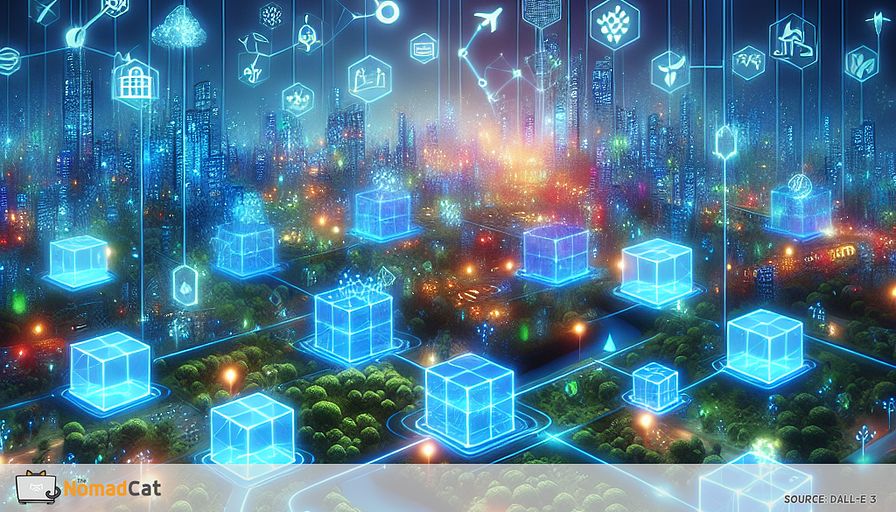Abstract:
The article highlights the growing importance of environmental sustainability and how blockchain technology is revolutionizing carbon offsetting by enhancing transparency and efficiency. European startups like ClimateTrade and Poseidon Foundation are at the forefront, using blockchain to ensure every carbon credit transaction is traceable and reliable, thus encouraging more participation. These startups creatively integrate carbon credits into everyday activities, such as consumer purchases, to promote real-time offsetting and support conservation efforts. Blockchain also plays a vital role in supply chain transparency, with companies like Provenance and Everledger tracing product origins to promote accountability. In renewable energy, blockchain facilitates peer-to-peer trading and tracks renewable energy certificates, with platforms like Power Ledger and WePower leading innovations. Despite facing regulatory challenges, European startups are aligning with frameworks like the EU Green Deal to enhance sustainability initiatives. Although scalability and energy consumption pose challenges, solutions like the Lightning Network and Proof of Stake models are being adopted to align blockchain with sustainability goals. Overall, blockchain is paving the way for a sustainable future by simplifying transactions and empowering consumers to engage in sustainability efforts seamlessly.
The significance of environmental sustainability is increasingly recognized today. Carbon offsetting can be complex, but blockchain technology offers viable solutions by tracking carbon credit transactions in a transparent and reliable manner. Across Europe, startups are leveraging blockchain to revolutionize carbon offsetting, enhancing both ease and transparency.
Blockchain's Role in Carbon Offsetting
Blockchain technology is transforming carbon offsetting by enhancing transparency and efficiency. European startups are at the forefront of this transformation, exploring innovative applications of blockchain.
Transparent Carbon Credit Ecosystems
Transparency is crucial in carbon offsetting. Blockchain ensures that every carbon credit transaction is permanently recorded, mitigating risks such as double counting. This fosters trust, encouraging companies and individuals to engage confidently in carbon offsetting. ClimateTrade and Poseidon Foundation exemplify the use of blockchain for transparency and traceability in transactions, with Poseidon even integrating carbon credits into everyday purchases.
Startups are creating audit trails that enhance trust among participants. Veridium Labs and CarbonX are making carbon credits more tradable and accessible by integrating them into loyalty programs. This simplifies claim verification and ensures transaction integrity, promoting wider participation.
Innovative Applications in Carbon Offsetting
In Spain, ClimateTrade employs blockchain to streamline carbon credit transactions, offering a straightforward platform for companies to procure credits. This integration simplifies offsetting processes within corporate operations. Meanwhile, in the UK, Poseidon Foundation embeds carbon credits into consumer purchases, enabling real-time offsetting and supporting forest conservation projects, thus integrating carbon offsetting into daily life.
Ensuring Traceability and Sustainability
Blockchain provides transparency in supply chains, which is essential for ethical sourcing. Startups like Provenance and Everledger offer solutions that trace products from origin to consumer, promoting sustainability. Provenance collaborates with consumer goods companies to ensure transparency, transforming supply chains to be more accountable.
Partnerships and Collaborations
Collaborations between tech startups and traditional industries facilitate the integration of blockchain into supply chains, merging innovative blockchain solutions with established networks. This enhances efficiency and transparency. For instance, blockchain audit trails foster trust among supply chain participants, improving efficiency and promoting sustainable practices.
Tracking Renewable Energy with Blockchain
The shift towards renewable energy is vital, and blockchain is aiding efficient tracking and trading of renewable energy.
Blockchain for Energy Trading
Blockchain enables peer-to-peer energy trading, allowing consumers to trade excess solar energy with neighbors. Platforms like Power Ledger and WePower are leaders in this area, creating microgrids and tokenizing green energy, democratizing energy distribution.
Tracking Renewable Energy Certificates
Startups utilize blockchain to track renewable energy certificates, ensuring each energy unit is accounted for. Electron digitizes these certificates, making them easily traceable and verifiable, thereby building trust in the market.
Optimizing Distributed Energy Resources
Blockchain aids in managing distributed energy resources by securely sharing real-time data. Grid Singularity in Austria is developing decentralized energy exchanges, enhancing market efficiency and facilitating local energy markets.
Smart Contracts for Improved Energy Management
Smart contracts in blockchain automate energy transactions, enhancing grid efficiency by matching supply with demand. This reduces waste and ensures effective use of renewable energy.
Navigating the Blockchain Regulatory Landscape in Europe
European startups navigate a complex regulatory environment, but the European Blockchain Partnership provides a framework that aligns with the EU Green Deal. This helps startups enhance their sustainability initiatives while complying with regulations, boosting their market appeal.
Exploring Market Opportunities through Blockchain
Blockchain opens new market opportunities in sustainability. Startups apply it in supply chain transparency, carbon credit trading, and decentralized energy systems. Tokenization of carbon credits streamlines trading and enhances transparency. Aligning with regulatory frameworks and consumer preferences helps startups tap into new markets.
Challenges and Future Directions in Blockchain Sustainability
Overcoming Scalability and Energy Challenges: Scalability and energy consumption present challenges for blockchain in sustainability. Layer 2 solutions like the Lightning Network improve transaction speed by processing off-chain. Transitioning to Proof of Stake models, such as Ethereum 2.0, reduces energy consumption, aligning blockchain with sustainability goals.
Future Trends and Innovations: Blockchain's potential in environmental sustainability is significant. Trends like tokenizing environmental assets and blockchain-based crowdfunding for green projects offer new opportunities. These innovations democratize access to sustainable investments and enhance market transparency.
Blockchain is paving the way for a sustainable future, particularly in carbon offsetting and renewable energy. By making transactions transparent and accountable, blockchain becomes a partner in building a greener planet. Startups like ClimateTrade and Poseidon Foundation are leading the way, making carbon credits part of everyday actions. This technology not only simplifies transactions but also empowers consumers to engage in sustainability efforts seamlessly. Blockchain's potential to optimize energy resources and enhance supply chain transparency offers a promising path forward.














